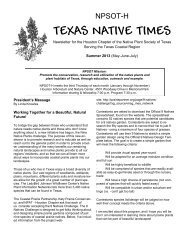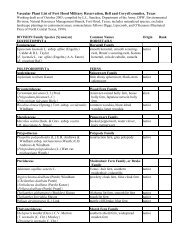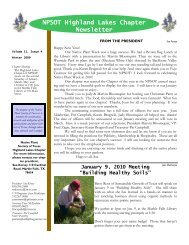Acanthaceae (PDF file)
Acanthaceae (PDF file)
Acanthaceae (PDF file)
You also want an ePaper? Increase the reach of your titles
YUMPU automatically turns print PDFs into web optimized ePapers that Google loves.
<strong>Acanthaceae</strong><br />
Acanthus Family
Introduction<br />
• Perennial herbs, vines<br />
or occasionally shrubs<br />
• Sometimes armed
Leaves<br />
• Simple<br />
• Usually entire<br />
• Oppositely arranged<br />
(decussate)<br />
• Exstipulate (no stipules)
Inflorescence<br />
• Determinate<br />
(inflorescence in which<br />
the terminal or central<br />
flower opens first)<br />
– Cymose<br />
– Often appearing<br />
racemose, paniculate, or<br />
spicate<br />
• Flower sometimes<br />
solitary
Flowers<br />
• Zygomorphic<br />
(bilaterally symmetrical)<br />
• Perfect<br />
• Hypogenous (superior<br />
ovary)<br />
• Showy<br />
• With nectariferous disc<br />
• Often subtended by<br />
conspicuous bracts
Calyx<br />
• Synsepalous (sepals<br />
fused together)with 5<br />
or sometimes 4 lobes<br />
• Convolute (overlapping)<br />
or imbricate<br />
(overlapping like<br />
shingles)<br />
• Persistent
Corolla<br />
• Sympetalous with 5<br />
lobes<br />
• Usually bilabiate<br />
(having 2 lips)<br />
• Imbricate or convolute<br />
• Variously colored
• Usually 4 stamens<br />
• Didynamous<br />
– If didynamous then 1<br />
staminode present<br />
• Sometimes reduced to<br />
2 stamens and 2<br />
staminodes<br />
• Epipetalous<br />
• Filaments distinct or<br />
coherent in pairs<br />
Androecium
• Anthers more or less<br />
basifixed<br />
• 2- or 1-locular<br />
– Locules unequal and at<br />
different levels<br />
• Sometimes spurred<br />
and/or hairy<br />
• Sometimes with<br />
prominent connective<br />
• Dehiscing longitudinally<br />
Androecium
• Of 1 pistil<br />
– 2-carpellate<br />
• Superior ovary<br />
– 2-locular<br />
• 1 style<br />
– Slender<br />
– Filiform<br />
• Stigmas 1-2<br />
– Funnelform or 2-lobed<br />
– Often with a reduced<br />
posterior lobe<br />
Gynoecium
Gynoecium<br />
• Ovules 2-10 in 2 rows in<br />
each locule with<br />
modified funicle<br />
• Placentation axile
Fruit<br />
• An elastic loculicidal<br />
capsule<br />
– With 2 recurving valves<br />
• Seeds usually flat<br />
– Supported by small<br />
hook-like projections<br />
• Retinacula<br />
• Jaculators
Fruit<br />
• With very thin,<br />
mucilaginous (slimy)<br />
seed coat<br />
• Endosperm usually<br />
absent<br />
• Embryo large<br />
– Curved, bent, sometimes<br />
straight
Representative<br />
Genera
Anisacanthus quadrifidus var. wrightii<br />
• Small, bushy shrub 61-122 cm<br />
tall<br />
• Soft hairs line the stems from<br />
between one pair of leaves to<br />
the axils of the next lower leaf<br />
pair<br />
• Lanceolate leaves up to 5.7 cm<br />
long, with petiole; hairs line the<br />
midrib and petiole<br />
• Orange flowers about 3.8 cm<br />
long and in terminal spikes<br />
Flame acanthus
Dyschoriste linearis<br />
Snake herb<br />
• Rather stiffly upright, coarsely and<br />
stiffly hairy perennial, 18-30 cm tall;<br />
stems 4-angled, few to several,<br />
usually unbranched<br />
• Leaves 16-50 mm long, opposite,<br />
stalkless, rather rigid; margins fringed<br />
with hairs<br />
• Flowers 16-35 mm long, bluishpurple<br />
or lavender, dark-spotted in<br />
throat, hairy outside, somewhat<br />
tubular, 2-lipped; upper lip unlobed;<br />
lower lip deeply 3-lobed; stalkless,<br />
from upper leaf axils
Justicia americana<br />
American water-willow<br />
• Upright, smooth perennial herb to 76 cm;<br />
stems angled, slender, branched in upper<br />
portion, usually rooting in lower portion<br />
• Leaves 7.6-15 cm long, narrow, opposite,<br />
stalkless or almost so, narrowed at both<br />
ends; margins entire<br />
• Flowers 10-13 mm long, white or<br />
occasionally violet, dotted with purple, 2-<br />
lipped; upper lip notched or 2-lobed,<br />
turned backward; lower lip deeply 3-<br />
lobed, occasionally turned under; flowers<br />
few, in cluster at tip of long stalk from<br />
leaf axils
Ruellia drummondiana<br />
• Coarse erect plant, 30-91<br />
cm tall; stem 4-angled<br />
covered with short, stiff,<br />
slightly rough hairs<br />
• Leaves 5-15 cm long with<br />
undulating margins; on<br />
petioles 1.3-2.5 cm long;<br />
usually dark green on the<br />
upper surface and pale<br />
green on the lower surface<br />
• Cluster of 2-7 flowers grow<br />
from leaf axils; purple to<br />
light purple; 3.8 cm long<br />
Drummond's ruellia
Ruellia humilis<br />
Fringeleaf wild petunia<br />
• Upright to somewhat sprawling, clumped,<br />
rather stout, conspicuously hairy perennial up<br />
to 81 cm tall; stems usually several in a clump,<br />
prominently 4-angled, branched; branches<br />
slender often lying on the ground<br />
• Leaves to 8 cm long, 4.5 cm wide, opposite,<br />
essentially stalkless, somewhat crowded on<br />
the stem; blade leathery, blunt or wedgeshaped<br />
at base and extending onto stalk, blunt<br />
or sharp-pointed at tip, densely hairy on veins<br />
and margins<br />
• Flowers 5-8 cm long to 2 cm wide, lavender to<br />
purplish-blue, usually with darker markings in<br />
the throat, trumpet-shaped, deeply 5-lobed at<br />
the rim; flowers few in clusters from middle<br />
and upper leaf axils
Ruellia nudiflora<br />
Violet ruellia<br />
• Upright to semi-sprawling perennial to<br />
71 cm tall from a somewhat woody<br />
base; stem solitary, branching in upper<br />
portion; plant densely hairy when young<br />
becoming almost entirely smooth with<br />
age<br />
• Leaves generally 6 cm long and 3 cm<br />
wide, opposite, stalked; blade graygreen,<br />
prominently net-veined on lower<br />
surface; margins curled or wavy-toothed<br />
• Flowers 55 mm long, 38 mm wide,<br />
lavender to purple, trumpet-shaped,<br />
deeply 5-lobed at rim, conspicuously<br />
curved, falling from plant in early<br />
afternoon
• Duration: Perennial<br />
Habit: Herb<br />
Leaf Complexity: Simple<br />
Leaf Shape: Ovate<br />
Leaf Venation: Pinnately<br />
Veined<br />
Leaf Pubescence:<br />
Puberulent<br />
Leaf Margin: Undulate<br />
Leaf Apex: Rounded<br />
Leaf Base: Rounded<br />
Flower Size: 7 cm long<br />
Sepals: calyx lobes linearattenuate<br />
Size Class: 1-3 ft.<br />
Ruellia occidentalis<br />
Western wild petunia
NEXT<br />
Solanaceae<br />
Nightshade<br />
Family





